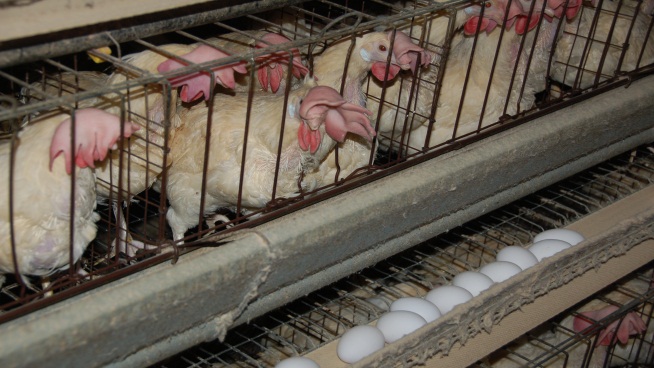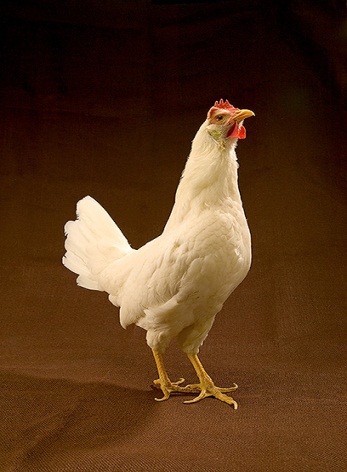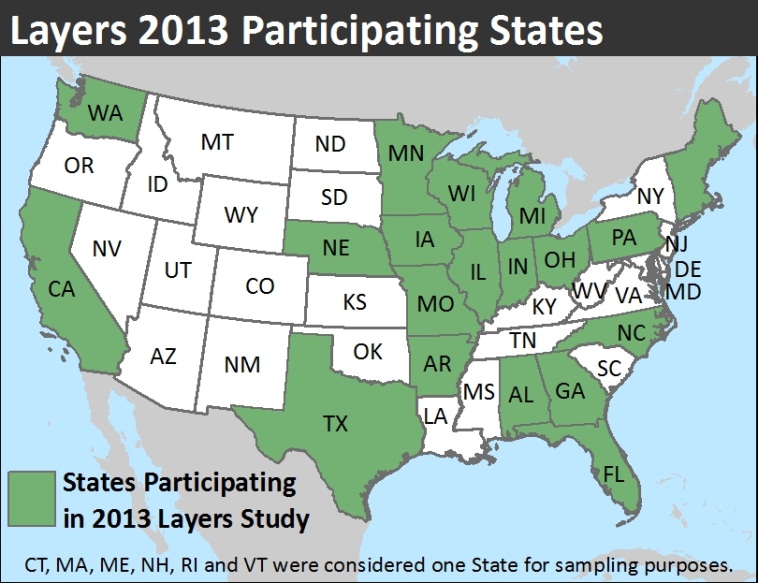Study Info Sheet
Study Info Sheet.docx
National Animal Health Monitoring System: Layers 2013 Study
Study Info Sheet
OMB: 0579-0404


Participate in USDA’s Layers 2013 Study
In June 2013, the USDA’s National Animal Health Monitoring System (NAHMS) will begin the Layers 2013 study. This national study will take an in-depth look at table-egg layer operations in the United States and provide the industry with an update of critical information last collected during the NAHMS Layers ’99 study.
Study focus
Due to the recent increased attention to Salmonella Enteritidis (SE) on table-egg farms, NAHMS was asked to conduct a national study to address this issue. NAHMS worked with an array of stakeholders to define the most critical information needs regarding SE. The following study objectives were identified:
Update previously collected information on layer farm management practices relevant to SE.
Estimate the prevalence of SE on layer farms.
Investigate risk factors for SE on layer farms.
What participation involves
Select operations with an inventory of 3,000 or more laying hens in 19 States (see map) will be asked to provide important health and management information to characterize the table-egg layer industry. Data collection will begin June 2013. Representatives from USDA’s Animal and Plant Health Inspection Service will interview table-egg layer producers to complete a questionnaire.
“I
recommend that
all producers respond to the NAHMS Layers 2013 study to gather
valuable data on the prevalence of Salmonella Enteritidis and the
control measures used. This will aid both producers and regulators
in determining the future direction of SE control.”
—Eric
Gingerich, DVM
Executive Director of the Association of Veterinarians in Egg
Production


![]()
![]()
January 2013

Benefits of the Layers 2013 study
In-depth reports and information sheets that will enable study participants to compare their operations—including management decisions and practices—with other farms.
Statistically valid information on SE prevalence and contemporary management practices used to control SE.
Information that can be used to develop appropriate policies and augment the decision-making process.
National estimates describing changes in management practices on table egg farms since 1999.
A scientific approach
NAHMS collects and reports accurate and useful information on animal health and management in the United States. Since 1990, NAHMS has developed national estimates on disease prevalence and other factors related to the health of U.S. beef cattle, sheep, goat, dairy cattle, swine, equine, poultry, and catfish populations. The science-based results produced by NAHMS have proven to be of considerable value to the U.S. livestock, poultry, and aquaculture industries as well as to other animal health stakeholders.
NAHMS studies are
National in scope
Science based
Statistically valid
Collaborative
Voluntary
Confidential
Confidentiality
NAHMS is a statistical unit under the Confidential Information Protection and Statistical Efficiency Act (CIPSEA). All information acquired under the Layers 2013 study will be used for statistical purposes only and will be treated as confidential in accordance with CIPSEA guidelines. Only summary estimates based on the inference population will be reported.
“The Layers 2013 study gives the egg industry a wonderful
opportunity to validate all the time and effort put into
implementing preventive controls for Salmonella Enteritidis since
the first Layers study was conducted in 1999 and since the Food and
Drug Administration’s 2009 Egg Safety Rule was implemented. I
highly encourage all egg producers that have the opportunity to
participate in this important, timely study.” —Krista
N. Eberle
Director of Food Safety Programs
United Egg Producers
For more information, contact:
USDA–APHIS–VS–CEAH–NAHMS
NRRC Building B, M.S. 2E7
2150 Centre Avenue
Fort Collins, CO 80526-8117
970.494.7000
Or visit NAHMS at http://nahms.aphis.usda.gov
#666.0113
Issued January 2013
____________________________________
The U.S. Department of Agriculture (USDA) prohibits discrimination in all its programs and activities on the basis of race, color, national origin, age, disability, and where applicable, sex, marital status, familial status, parental status, religion, sexual orientation, genetic information, political beliefs, reprisal, or because all or part of an individual’s income is derived from any public assistance program. (Not all prohibited bases apply to all programs.) Persons with disabilities who require alternative means for communication of program information (Braille, large print, audiotape, etc.) should contact USDA’s TARGET Center at (202) 720–2600 (voice and TDD). To file a complaint of discrimination, write to USDA, Director, Office of Civil Rights, 1400 Independence Avenue, S.W., Washington, D.C. 20250–9410, or call (800) 795–3272 (voice) or (202) 720–6382 (TDD). USDA is an equal opportunity provider and employer.
Photographs of caged chickens and facilities courtesy of Dr. Gregg Cutler. Photograph of solitary chicken courtesy of USDA photo library.

| File Type | application/vnd.openxmlformats-officedocument.wordprocessingml.document |
| Author | aberry |
| File Modified | 0000-00-00 |
| File Created | 2021-01-30 |
© 2025 OMB.report | Privacy Policy